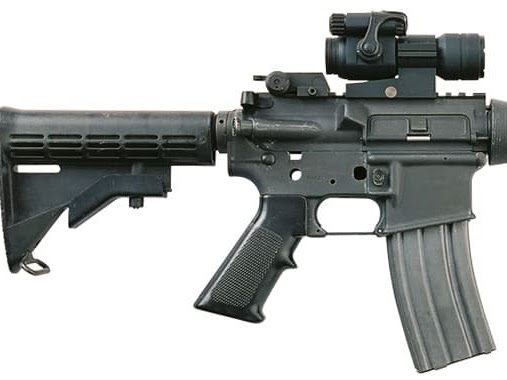Best Pics of the Month: September 2020
The USS Sterett steams through the night in the Gulf of Oman, Sept. 17, 2020. (Photo By: Navy Seaman Drace Wilson)
A U.S Air Force F-16 Fighting Falcon assigned to the 510th Fighter Squadron, Aviano Air Base, Italy, takes off from RAF Lakenheath, United Kingdom, Sept. 1, 2020. The 510th FS is conducting close air support training with the 321st Special Tactics Squadron, the 19th Regiment Royal Artillery and the 2nd Air Support Operations Squadron to enhance combat capabilities in support of European theater operations. (U.S. Air Force photo by Airman 1st Class Jessi Monte)
Tech. Sgt. John Rodiguez, 321st Contingency Response Squadron security team, patrols with a Ghost Robotics Vision 60 prototype at a simulated austere base during the Advanced Battle Management System exercise on Nellis Air Force Base, Nev., Sept. 3, 2020. The ABMS is an interconnected battle network - the digital architecture or foundation - which collects, processes and shares data relevant to warfighters in order to make better decisions faster. In order to achieve all-domain superiority, it requires that individual military activities not simply be de-conflicted, but rather integrated – activities in one domain must enhance the effectiveness of those in another domain. (U.S. Air Force photo by Tech. Sgt. Cory D. Payne)
Marines fire an M777A2 howitzer during training at Pohakuloa Training Area, Hawaii, Sept. 20, 2020. (Photo By: Marine Corps Sgt. Luke Kuennen)
Marine Corps Sgt. Nicholas Luber fires a machine gun during a training flight over Naval Air Facility El Centro, Calif., Sept. 4, 2020. (Photo By: Marine Corps Lance Cpl. Gavin Umboh)
An Air Force F-15E Strike Eagle receives fuel from a KC-135 Stratotanker over Southwest Asia, Sept. 12, 2020. (Photo By: Air Force Master Sgt. Larry Reid Jr.)
A B-1 Lancer departs Eielson Air Force Base, Alaska, Sept. 14, 2020, on its way to Europe in support of a Bomber Task Force mission. BTF missions enable crews to maintain a high state of readiness and proficiency while assuring regional allies and partners of the U.S. commitment to stability throughout the European continent. (U.S. Air Force photo by Senior Master Sgt. Ted Daigle)
A Navy F/A-18E Super Hornet receives fuel from an Air Force KC-135 Stratotanker while flying in the U.S. Central Command area of responsibility, Sept. 22, 2020. (Photo By: Air Force Staff Sgt. Jason Allred)
C-130 crews with the Minnesota Air National Guard conduct air drop and aerial flare release training above Camp Ripley, Minn., Sept 16, 2020. (Photo By: Anthony Housey, Minnesota National Guard)
Maj. Cody Wilton, A-10 Thunderbolt II Demonstration Team commander and pilot, flies alongside Capt. Kristin Wolfe, F-35A Lightning II Demonstration Team pilot, Maj. Garret Schmitz, F-16 Viper Demonstration Team pilot, and a P-51 Mustang as part of a heritage flight formation for the Tri-City Water Follies Drive-In Airshow at Kennewick, Wash., Sept. 4, 2020. The heritage flight was flown as a showcase of past, present and future Air Force aviation. (U.S. Air Force photo by Capt. Kip Sumner)
An Air Force KC-135 Stratotanker, F-15C Eagles and F-15E Strike Eagles fly in formation with Royal Saudi Air Force F-15SAs during a large formation exercise over Saudi Arabia, Sept. 10, 2020. (Photo By: Air Force Senior Airman Duncan C. Bevan)
Left to right: The USNS Charles Drew, the USS Comstock, the USS Shiloh, the USS New Orleans, the USS Chicago, the USS America, the USS Ronald Reagan, the USNS John Ericsson, the USS Antietam, the USS Germantown and the USNS Sacagawea sail in formation with Navy and Air Force aircraft during Valiant Shield in the Philippine Sea, Sept. 25, 2020. The exercise is designed to focus on integration of joint training in a blue-water environment among U.S. forces. (Photo By: Navy Petty Officer 3rd Class Erica Bechard)
A Navy MH-60 Seahawk helicopter pulls a service member out of the water during a mine countermeasures interoperability exercise in the Persian Gulf, Sept. 10, 2020.
Left to right: USS Germantown, USNS John Ericsson, USS Antietam, USS Ronald Reagan, USS America, USS Shiloh, USS New Orleans and USS Comstock break away from formation during Exercise Valiant Shield in the Philippine Sea, Sept. 25, 2020.
Navy warships sail in formation with Australian, Korean and Japanese vessels during Pacific Vanguard in the Pacific Ocean, Sept. 14, 2020. The exercise is designed to improve multinational interoperability. (Photo By: Official Japan Maritime Self-Defense Force)




























































